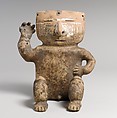Seated Figure
Not on view
The people inhabiting the hills and valleys of the middle Cauca River during the centuries before the Spanish conquest in the 1530s made distinctive ceramic figures of the type illustrated here. The stylized figures are known familiarly as slab figures. They can be solid or hollow, male or female, although most are male. They range in height from four to twenty inches. Square or rectangular slabs of clay make up the head and body and heavy coils of clay are attached for arms and legs. The neck is usually a deep groove with little further modeling, but this example shows a collarbone. Left hand to chest, the right arm is raised, the palm open as if throwing or holding something. Legs bent, the figure's feet are squarely placed on the ground. Wide, shallow grooves around the ankles, below the knees, and around the wrists and upper arms indicate that leg and arm bands were once present. The eyes and mouth are long horizontal slits while the large nose is realistically modeled. The septum is pierced to hold a now missing nose ring, perhaps one of gold or copper. The majority of slab figures have survived without paint, but face paint remains on some, such as the white seen on this figure.
Slab figures were included with ceramic vessels and metal ornaments as offerings in burials in shaft and chamber tombs. They may have been considered guardians or companions for the deceased.
This image cannot be enlarged, viewed at full screen, or downloaded.

